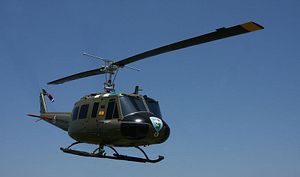A few Asia-Pacific defense and security links to wrap up the week:
The Associated Press reports that Vietnam will ground its Vietnam War-era U.S.-made UH-1 Huey choppers after a Huey crash killed four Vietnamese soldiers. Army Deputy Chief of Staff Lt. Gen. Vo Van Tuan said that Vietnam’s entire Huey fleet would be grounded indefinitely for maintenance checks.
Brunei confirmed that it will transfer its S-70As Black Hawk helicopters to Malaysia. The two countries released a statement titled “Defense Cooperation between Brunei Darussalam and Malaysia” in which they stated that the Royal Brunei Air Force’s S-70As will be transferred to Malaysia in September. Brunei will use S-70i Black Hawks (the international military version, assembled in Poland) instead.
Myanmar’s defense budget in 2015 will be $2.5 billion, representing a 10 percent year-on-year increase. The figure represents 3.7 percent of Myanmar’s national GDP. Myanmar is a highly militarized state and is currently engaged in internal campaigns against rebels in the country’s northern province of Kachin.
Over at the always excellent Lawfare blog, Yishai Schwartz breaks down the Corker bill on Iran. Bob Corker hasn’t been shy in calling for additional congressional oversight over the Obama administration’s attempts at diplomacy with Iran. While the text of the bill is not final as of yet, it is beginning to gather bipartisan support and could seriously destabilize the ongoing rapprochement between the United States and Iran.
Over at The National Interest, Diplomat columnist and former editorial assistant Akhilesh Pillalamarri has a great primer on Chanakya’s Arthashastra, a political treatise that Henry Kissinger famously described as a “a combination of Machiavelli and Clausewitz.” Arthashastra is the closest South Asian analogue to Sunzi’s Art of War, but is generally far less known and appreciated in the west. As far as the text’s realist underpinnings go, it remains an immensely valuable source of insight into the general principles of war, peace, and governance.
In case you missed it, here’s a round up of our coverage of U.S. President Barack Obama’s trip to India. I compiled a primer breaking down the primary points of interest that came out of the visit. Additionally, my colleagues Franz Stefan-Gady and Prashanth Parameswaran joined me for a candid discussion of both the specifics of the visit and some general trends in U.S.-India relations earlier this week on our podcast. Another colleague, Shannon Tiezzi, sat down with Milan Vaishnav of CEIP for a video recap of the trip and its outcomes. Harsh V. Pant, in Flashpoints, writes that Obama’s visit in January and Modi’s visit back in September herald a period of “long-term convergence” between the U.S. and India. Sanjay Kumar over at The Pulse, meanwhile, is more skeptical of the theatrics accompanying U.S.-India diplomacy.
Also, be sure to take a look at the newest issue of our app which includes some great writing by Flashpoints regular Robert Farley on innovation in China’s defense sector and a separate piece on Afghanistan’s future as international troops withdraw.

































